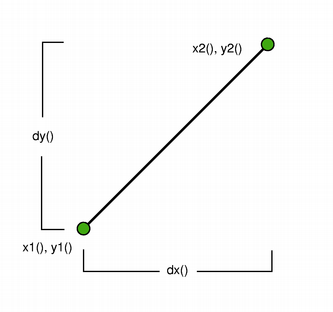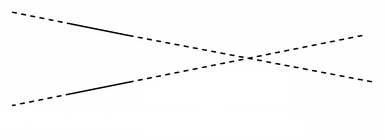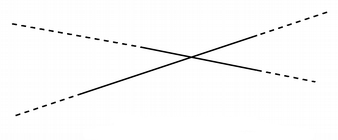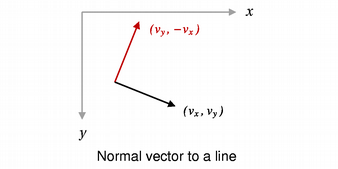| Home · All Classes · Modules |
The QLineF class provides a two-dimensional vector using floating point precision. More...
This class can be pickled.
The QLineF class provides a two-dimensional vector using floating point precision.
A QLineF describes a finite length line (or line segment) on a two-dimensional surface. QLineF defines the start and end points of the line using floating point accuracy for coordinates. Use the toLine() function to retrieve an integer based copy of this line.
 |
 |
The positions of the line's start and end points can be retrieved using the p1(), x1(), y1(), p2(), x2(), and y2() functions. The dx() and dy() functions return the horizontal and vertical components of the line, respectively.
The line's length can be retrieved using the length() function, and altered using the setLength() function. Similarly, angle() and setAngle() are respectively used for retrieving and altering the angle of the line. Use the isNull() function to determine whether the QLineF represents a valid line or a null line.
The intersect() function determines the IntersectType for this line and a given line, while the angleTo() function returns the angle between the lines. In addition, the unitVector() function returns a line that has the same starting point as this line, but with a length of only 1, while the normalVector() function returns a line that is perpendicular to this line with the same starting point and length.
Finally, the line can be translated a given offset using the translate() function, and can be traversed using the pointAt() function.
Describes the intersection between two lines.
 |
 |
| QLineF.UnboundedIntersection | QLineF.BoundedIntersection |
| Constant | Value | Description |
|---|---|---|
| QLineF.NoIntersection | 0 | Indicates that the lines do not intersect; i.e. they are parallel. |
| QLineF.UnboundedIntersection | 2 | The two lines intersect, but not within the range defined by their lengths. This will be the case if the lines are not parallel. |
intersect() will also return this value if the intersect point is within the start and end point of only one of the lines.
| Constant | Value | Description |
|---|---|---|
| QLineF.BoundedIntersection | 1 | The two lines intersect with each other within the start and end points of each line. |
See also intersect().
Constructs a null line.
Constructs a line object that represents the line between p1 and p2.
Constructs a line object that represents the line between (x1, y1) and (x2, y2).
Construct a QLineF object from the given integer-based line.
See also toLine().
Returns the angle of the line in degrees.
The return value will be in the range of values from 0.0 up to but not including 360.0. The angles are measured counter-clockwise from a point on the x-axis to the right of the origin (x > 0).
This function was introduced in Qt 4.4.
See also setAngle().
Returns the angle (in positive degrees) from this line to the given line, taking the direction of the lines into account. If the lines do not intersect within their range, it is the intersection point of the extended lines that serves as origin (see QLineF.UnboundedIntersection).
The returned value represents the number of degrees you need to add to this line to make it have the same angle as the given line, going counter-clockwise.
This function was introduced in Qt 4.4.
See also intersect().
Returns the horizontal component of the line's vector. Return value is positive if x2() >= x1() and negative if x2() < x1().
Returns the vertical component of the line's vector. Return value is positive if y2() >= y1() and negative if y2() < y1().
Returns a QLineF with the given length and angle.
The first point of the line will be on the origin.
Positive values for the angles mean counter-clockwise while negative values mean the clockwise direction. Zero degrees is at the 3 o'clock position.
This function was introduced in Qt 4.4.
Returns a value indicating whether or not this line intersects with the given line.
The actual intersection point is extracted to intersectionPoint (if the pointer is valid). If the lines are parallel, the intersection point is undefined.
Returns true if the line is not set up with valid start and end point; otherwise returns false.
Returns the length of the line.
See also setLength().
Returns a line that is perpendicular to this line with the same starting point and length.

See also unitVector().
Returns the line's start point.
See also setP1(), x1(), y1(), and p2().
Returns the line's end point.
See also setP2(), x2(), y2(), and p1().
Returns the point at the parameterized position specified by t. The function returns the line's start point if t = 0, and its end point if t = 1.
Sets the angle of the line to the given angle (in degrees). This will change the position of the second point of the line such that the line has the given angle.
Positive values for the angles mean counter-clockwise while negative values mean the clockwise direction. Zero degrees is at the 3 o'clock position.
This function was introduced in Qt 4.4.
See also angle().
Sets the length of the line to the given length. QLineF will move the end point - p2() - of the line to give the line its new length. If the given length is negative the angle() is also changed.
If the line is a null line, the length will remain zero regardless of the length specified.
See also length() and isNull().
Sets this line to the start in x1, y1 and end in x2, y2.
This function was introduced in Qt 4.4.
See also setP1(), setP2(), p1(), and p2().
Sets the starting point of this line to p1.
This function was introduced in Qt 4.4.
Sets the end point of this line to p2.
This function was introduced in Qt 4.4.
Sets the start point of this line to p1 and the end point of this line to p2.
This function was introduced in Qt 4.4.
See also setP1(), setP2(), p1(), and p2().
Returns an integer based copy of this line.
Note that the returned line's start and end points are rounded to the nearest integer.
See also QLineF().
Translates this line by the given offset.
This is an overloaded function.
Translates this line the distance specified by dx and dy.
Returns this line translated by the given offset.
This function was introduced in Qt 4.4.
This is an overloaded function.
Returns this line translated the distance specified by dx and dy.
This function was introduced in Qt 4.4.
Returns the unit vector for this line, i.e a line starting at the same point as this line with a length of 1.0.
See also normalVector().
Returns the x-coordinate of the line's start point.
See also p1().
Returns the x-coordinate of the line's end point.
See also p2().
Returns the y-coordinate of the line's start point.
See also p1().
Returns the y-coordinate of the line's end point.
See also p2().
This method is only available if the QtGui module is imported.
This method is only available if the QtGui module is imported.
| PyQt 4.12.1 for X11 | Copyright © Riverbank Computing Ltd and The Qt Company 2015 | Qt 4.8.7 |